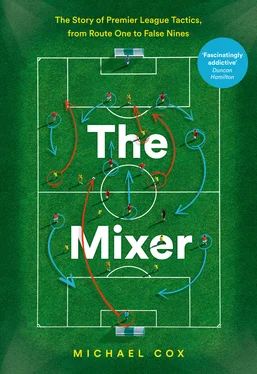Other, less celebrated goalkeepers adjusted well, like Norwich’s Bryan Gunn, who contributed to his side’s excellent passing football. Seaman also coped admirably, partly because he was accustomed to playing behind Arsenal’s famously aggressive offside trap and was encouraged to sweep proactively by George Graham. Even before the back-pass change, Graham had Seaman working on kicking the ball with his weaker foot, then an extremely rare skill for a goalkeeper, although the rule change did cause him problems. ‘When the rule came in, first of all, you went to the safety route,’ he admitted. ‘If someone passed it back to you, just booted it, you just made sure you got good contact. Then you develop that and get a bit more confident with the ball, so you try to control it … the more you do it, the better you get – you learn who to pass to, where to find players.’ As goalkeepers increasingly passed the ball rather than hoofed it, they acted as an eleventh outfielder, and teams started playing out from the back.
Schmeichel, meanwhile, once had a blazing row with Ferguson over the subject of his kicking. Manchester United were 3–0 up at Anfield in January 1994, but contrived to blow their lead and drew 3–3. Ferguson was understandably furious, but surprisingly targeted Schmeichel for continually sending balls up the middle of the pitch, where Neil Ruddock was heading them back, allowing Liverpool to maintain their pressure. Schmeichel didn’t appreciate the criticism, and after Ferguson had threatened to throw a cup of tea over his goalkeeper, he launched a volley of abuse. He later phoned his agent demanding a transfer, although Ferguson called him into his office the next day and told him that he was going to be sacked anyway. After the Dane apologised, both to his manager and his teammates, Ferguson reversed his decision, and Schmeichel spent five more years at the club, ending his extraordinary spell by lifting the European Cup as captain in 1999.
Schmeichel never entirely solved his kicking problems, however, making two atrocious errors with his feet both home and away in a 1998 FA Cup tie against relegation strugglers Barnsley, who won the replay. Considering the nature of his international success with Denmark, and his subsequent struggles with kicking, it’s impressive Schmeichel put personal preferences aside to declare that ‘the back-pass law is the best rule change ever – it has changed the game.’
Significantly, however, Schmeichel popularised the concept of a goalkeeper acting as a playmaker – but with his hands rather than his feet. His incredible long-range, overarm throws had barely been witnessed before in English football, and became a fundamental part of Manchester United’s attacking weaponry. Ferguson’s side largely played counter-attacking football at this stage, based heavily around wingers Ryan Giggs and either Andrei Kanchelskis or Lee Sharpe, who frequently received the ball on the run, because Schmeichel could accurately hurl the ball half the length of the pitch. ‘When I get hold of the ball, I try to create counter-attacking opportunities,’ Schmeichel explained. ‘It’s not always successful, but the tactic forces the opponents to turn around and head for their own goal, which is both strenuous and demoralising.’ Schmeichel even recorded assists with his hands. In February 1994, away at QPR, he launched the ball straight up the centre for the speedy Kanchelskis to dribble forward and open the scoring in a 3–2 win. Two years later, in a 5–0 thrashing of Sunderland – a game better remembered for Eric Cantona’s legendary chip into the top corner – Schmeichel caught a tame header and immediately, from three yards off his line, chucked the ball into the opposition half for Ole Gunnar Solskjær, who raced clear of the defence and finished calmly.
Not until Pepe Reina, who joined Liverpool in 2005, did the Premier League witness a goalkeeper so adept at these immediate, accurate long-range throws to launch counter-attacks. By this stage goalkeepers were generally also extremely comfortable with their feet, the majority growing up accustomed to the modern laws. ‘I was ten years old when they changed the back-pass rule,’ said Reina, who won the Premier League Golden Glove award three consecutive times. ‘I was still young enough, thankfully. It caught me just in time, as I was beginning to develop my skills.’ But even by this stage, in the mid-2000s, Reina’s kicking received significantly less attention than his throwing, indicative of how Schmeichel had created the template for the Premier League goalkeeper. ‘Schmeichel’s long throws were so powerful and allowed his team-mates to create danger at the other end … his approach was clearly ahead of his time,’ said Serie A veteran Samir Handanović. Nigeria’s Vincent Enyeama summarised the thoughts of a generation of keepers: ‘Even though Edwin van der Sar was my role model, Schmeichel brought in a different kind of goalkeeping.’ Schmeichel was the first Premier League player to provide inspiration across the world.
Van der Sar, who excelled for Manchester United around the same time as Reina was doing so for Liverpool, was famed for his quality in possession, primarily because he grew up at Ajax, where the visionary Johan Cruyff had insisted that the goalkeeper be an eleventh outfielder long before the back-pass change. Van der Sar became the accepted goalkeeping role model, with Thibaut Courtois and Manuel Neuer citing him as their inspiration because he was so comfortable on the ball. Kicking had become an essential part of modern goalkeeping, and those poor in possession found themselves marginalised.
Meanwhile, Schmeichel also helped revolutionise the Premier League in a different manner entirely. Of the 242 players who started a Premier League match on the Premier League’s opening weekend, just 11 were foreign. By virtue of simple probability, you’d expect only one of the 11 to be a goalkeeper. Instead, it was four: Schmeichel, plus Wimbledon’s Dutchman Hans Segers, Canadian international Craig Forrest at Ipswich and Czech Jan Stejskal for QPR. A year later, with overseas outfielders still rare, there were six more foreign regulars between the posts: Australian Mark Bosnich at Aston Villa, Russian Dmitri Kharine at Chelsea, Norwegian Erik Thorstvedt at Tottenham, Zimbabwe’s Bruce Grobbelaar, who had regained his place at Liverpool, and two more Czechs, Luděk Mikloško of West Ham and Pavel Srníček of Newcastle. Jim Barron, then the goalkeeping coach at Aston Villa, noted how foreign goalkeepers were more proactive than their English counterparts, commanding their box better and possessing superior distribution. England had always prided itself on the quality of its goalkeepers, but foreign imports were evolving the role.
Goalkeepers in the Premier League’s first couple of seasons were therefore significant for two clear reasons. First, the change to the back-pass law meant they broadened their skill set and became all-rounders rather than specialists, a development subsequently witnessed in every other position. Second, there was a concerted shift towards foreign players at the expense of homegrown talent, another process that would be replicated across the pitch. Goalkeepers were traditionally considered outsiders, but now they were leading the way into football’s modern age.
2
‘Being French, to me, is first and foremost being a revolutionary.’
Eric Cantona
Upon the formation of the Premier League, Manchester United hadn’t lifted the league trophy in a quarter of a century, which made their dominance of its early years even more remarkable. Alex Ferguson’s side triumphed in four of the first five seasons.
These five years coincided with the half-decade reign of Eric Cantona – and United’s only failure during this period, finishing second in 1994/95, came when the fantastic French forward was suspended for half the campaign. His impact upon United was extraordinary, turning them from also-rans to consistent champions almost overnight, and his influence on the Premier League was unparalleled. Cantona, more than anyone else, popularised technical football.
Читать дальше












